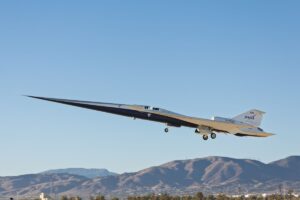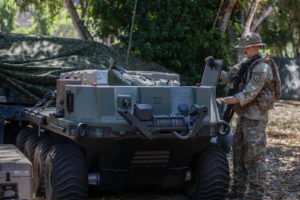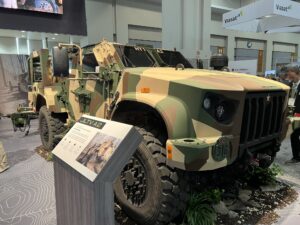Defense Daily
-
Wednesday, October 29, 2025
- Nominee For Assistant Secretary Of Defense For Space Policy Wants Review Of Commercial Strategies
- Nominee To Lead DoD Mission Capabilities Wants More Experimentation Events
- AM General Eyes Prototype In Mid-2026 To Help Inform Army’s M-MET Ground Robot Concept
- All.Space And Aalyria Partner On Multi-Orbit Orchestration For Defense Networks
- X-59 Flies For First Time From USAF Plant 42
-
Wednesday, October 29, 2025
- Nominee For Assistant Secretary Of Defense For Space Policy Wants Review Of Commercial Strategies
- Nominee To Lead DoD Mission Capabilities Wants More Experimentation Events
- AM General Eyes Prototype In Mid-2026 To Help Inform Army’s M-MET Ground Robot Concept
- All.Space And Aalyria Partner On Multi-Orbit Orchestration For Defense Networks
- X-59 Flies For First Time From USAF Plant 42
-
 Advanced / Transformational Technology
Advanced / Transformational TechnologyX-59 Flies For First Time From USAF Plant 42
The X-59 supersonic aircraft by Lockheed Martin‘s [LMT] Skunk Works division had its first flight from U.S Air Force Plant 42 in Palmdale, Calif., the company said on Tuesday. Billed […]
-
 Army
ArmyAM General Eyes Prototype In Mid-2026 To Help Inform Army’s M-MET Ground Robot Concept
AM General has said it could have a prototype ready in mid-2026 for the concept it’s developing with Textron Systems [TXT] and Carnegie Robotics for the Army’s potential Medium Modular […]
-
 Advanced / Transformational Technology
Advanced / Transformational TechnologyAll.Space And Aalyria Partner On Multi-Orbit Orchestration For Defense Networks
Satellite terminal developer All.Space and network orchestration software company Aalyria are teaming up to demonstrate interoperable communications across domains, specifically for defense scenarios. Under a new strategic partnership announced Tuesday, the companies said […]
-
 Space
SpaceNominee For Assistant Secretary Of Defense For Space Policy Wants Review Of Commercial Strategies
Marc Berkowitz, the nominee for assistant secretary of defense for space policy, wants to review commercial space strategies upon taking office. Berkowitz was an assistant deputy undersecretary of defense for […]
-
 Congress
CongressNominee To Lead DoD Mission Capabilities Wants More Experimentation Events
More experimentation to find and fix system problems early would boost the Defense Department’s goal of speeding the delivery of new capabilities to military forces in the field, the nominee […]
-
Tuesday, October 28, 2025
- Repurposing Of Reconciliation Funds For DoD Not A Solution, PSC Says
- As Army Plans JLTV Cut, AM General ‘On Track’ To Meet 2026 Fielding For Vehicles On-Order
- HII And South Korea’s Hyundai Agree To Jointly Bid For Navy Auxiliary Ships
- House Dems “Urgently Demand” End To Furloughs As Labs Send Workers Home
- Voyager Acquires Spacecraft Electric Propulsion Supplier ExoTerra
- After Union Narrowly Rejects Contract Offer, Boeing Says Focused On Contingency Plan
- Former Army Secretary To Become NTI President
-
Tuesday, October 28, 2025
- Repurposing Of Reconciliation Funds For DoD Not A Solution, PSC Says
- As Army Plans JLTV Cut, AM General ‘On Track’ To Meet 2026 Fielding For Vehicles On-Order
- HII And South Korea’s Hyundai Agree To Jointly Bid For Navy Auxiliary Ships
- House Dems “Urgently Demand” End To Furloughs As Labs Send Workers Home
- Voyager Acquires Spacecraft Electric Propulsion Supplier ExoTerra
- After Union Narrowly Rejects Contract Offer, Boeing Says Focused On Contingency Plan
- Former Army Secretary To Become NTI President
-
 Army
ArmyAs Army Plans JLTV Cut, AM General ‘On Track’ To Meet 2026 Fielding For Vehicles On-Order
As the Army plans to curtail future Joint Light Tactical Vehicle (JLTV) procurement, AM General has confirmed it remains on track to meet an initial fielding goal for the second […]


